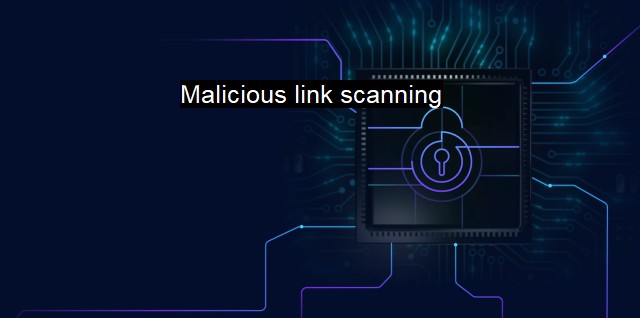What is Malicious link scanning?
The Importance of Malicious Link Scanning: Protecting Against Cyber Threats and Mitigating Attacks with Antivirus Programs
Malicious link scanning refers to the method or process used to identify and neutralize threats hidden within the URLs people encounter while surfing the internet. A prominent aspect of cybersecurity, malicious link scanning is often a standard feature of sophisticated defense software like antiviruses, aimed at preventing users from accessing websites or online resources that have been flagged as dangerous.The process of malicious link scanning involves examining the integrity and safety of links that interact with a program or a user before any actual interaction with the suspected link takes place. This sophisticated method of anticipatory threat detection creates a shield, preventing malware, phishing schemes, or other types of cyber-attacks from infiltrating a system.
Malware, short for malicious software, represents scripts or programs created with ill intent. These malware programs may be embedded in seemingly innocuous links in email messages or online ads. When a user clicks on the malware-infected link, it activates a program or a script to either directly harm the computer by corrupting files, crashing the system, or stealing sensitive information.
Phishing is another sinister form of a cyber-attack often hidden in the links that users click blissfully ignorant of any impending danger. These cyber threat organizations expertly craft emails and messages, often imitating reputable organizations, banks, or online stores. The phishing links embedded within these messages direct unsuspecting users to fabricated websites where they unknowingly provide passwords, credit card numbers, or other sensitive information.
Much in the arsenal of the cybercriminal ran into these deceptions is designed to exploit the human element, the weakest link in cybersecurity. Humans, being naturally curious, often click on web links without assessing the potential harm they could encounter. This innate vulnerability highlights the crucial role malicious link scanning has carved out in the niche of cybersecurity, acting as a buffer against potential data breaches.
Robust antivirus software, renowned as firewalls or internet security suites, often guarantee this critical malicious link scanning feature. Regulating incoming and outgoing internet traffic, the antivirus software scans the URLs for malicious content before allowing them to interact with the user's operating systems or networks. Should the software encounter a suspicious link or URL flagged in its databases, it prompts the user to steer away from the resource and find a safer alternative.
It's important to note that the implication and execution of malicious link scanning are plagued with some challenges. False positives are very common; this is a situation where a legitimate link is flagged as malicious, triggering an unnecessary defense action. On the other hand, tracking every single incident of malicious activity from numerous databases worldwide becomes overwhelmingly difficult, thereby leading to gaps in resilience.
Despite challenges, with the continuous advent of technology and malicious link scanning software development, it is anticipated that improvements addressing these setbacks will surely materialize.
On a macro level, malicious link scanning upholds the integrity of global cybersecurity infrastructure, making the internet safer and more reliable. It brings peace of mind to individuals and corporations by bolstering defenses in an era where much of life's essential engagements and transactions happen online, and the pace of cyber threats are rapidly increasing.
Malicious link scanning is the virtual equivalent of security screening in a physical world. It screens and filters the pathways of the digital world seeking to streamline the flow of safe and trusted interactions. It's a critical security measure, tried and tested, that continues to wage war in a battle against cyber threats, with global peace-of-mind its most substantial reward. Its importance can never be stressed enough, and it's those micro-moments of interaction with the digital world that make all the difference.

Malicious link scanning FAQs
What is malicious link scanning?
Malicious link scanning is the process of scanning hyperlinks or URLs to detect and block any malicious content that could harm a computer or network.How does malicious link scanning work?
Malicious link scanning works by identifying and analyzing the content of a link or URL. It then compares the content against a database of known malicious URLs, and if a match is found, the link is blocked to prevent any potential damage.Is malicious link scanning necessary for cybersecurity?
Yes, malicious link scanning is necessary for cybersecurity because it helps to protect users from falling victim to cyber-attacks that utilize malicious links. These attacks can result in the theft of sensitive data or the installation of malware on a user's device.What are some of the benefits of malicious link scanning?
There are several benefits to malicious link scanning, including: 1. Improved security by preventing cyber-attacks that use malicious links. 2. Increased productivity and decreased downtime by avoiding infections caused by malicious links. 3. Cost savings by preventing potential damages and losses. 4. Enhanced reputation by demonstrating a commitment to cybersecurity and protecting users.| | A | | | B | | | C | | | D | | | E | | | F | | | G | | | H | | | I | | | J | | | K | | | L | | | M | |
| | N | | | O | | | P | | | Q | | | R | | | S | | | T | | | U | | | V | | | W | | | X | | | Y | | | Z | |
| | 1 | | | 2 | | | 3 | | | 4 | | | 7 | | | 8 | | |||||||